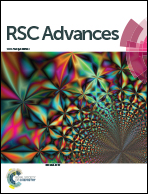Dilatational rheology studies on a semicrystalline ferroelectric copolymer at the air–water interface
Abstract
We report dilatational rheology studies on a Langmuir film of a ferroelectric copolymer, poly(vinylidene fluoride–trifluoroethylene) (70 : 30), under various surface pressures, temperatures and frequencies using the oscillatory barrier technique. We have employed both the Fourier transform method and Lissajous curves to extract the viscoelastic moduli corresponding to the fundamental mode and nonlinear parameters during the compression and expansion cycles, respectively. Strain sweep studies show that the dominant storage modulus increases, overshoots at 1.5% of strain and saturates beyond that; which is typical of the semicrystalline copolymer. Further, the nonlinear parameters show strain hardening of the film. Fixing the angular frequency and at a small strain regime, the temperature sweep studies on the film at the air–water interface provide evidence for the order–disorder phase transition with a pronounced discontinuity in dilatational moduli at 298 K which is also seen in nonlinear parameters. Frequency sweep studies show that the storage moduli are dominant over the loss moduli till a crossover point after which a reversal in this trend is observed. The crossover point is found to shift towards lower frequency and is sensitive to temperature.


 Please wait while we load your content...
Please wait while we load your content...